CAPTIONS: all photos taken by Field School

Dr. Tim watches as Tom from the Cold Spring Highway Department helps remove spoil piles from around the Boring Mill.
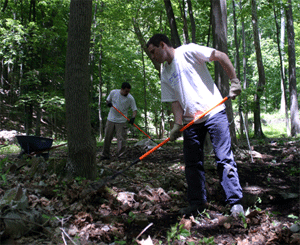
Dan (in back) and Cameron (in foreground) rake around the foundations of the Machine Shop to help define its edges.
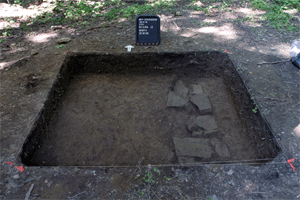
A formal photograph of an excavation unit showing the wall running north from the East Bank House foundation. The gap in the middle of the wall may indicate the former presence of a large structural timber.
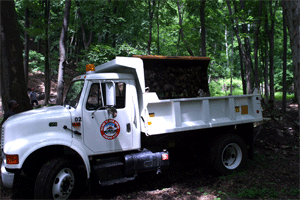
The Village Highway Department’s front end loader dumps back dirt into a dump truck to aid in site management while Bode looks on.
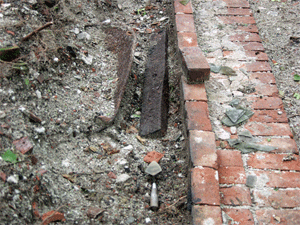
Potential iron ‘pig’ or ‘sow’ lies alongside the Machine Shop before we moved it to the lab before it was stabilized to prevent additional rusting.
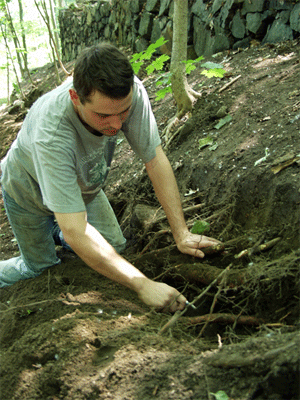
Cameron, the author, helps define the eastern edge of the Pond.
|
My name is Cameron Hartnell and I am a PhD student in the Social Sciences Department of Michigan Tech, studying Industrial Archaeology. My first experience with archaeological excavation methods was last year at the West Point Foundry site and I am enjoying utilizing those skills in my own project this year at the same site.
This week, week 4, was shortened by a half-day during Memorial Day on Monday and a day off on Friday to allow team members to attend the Society for Industrial Archaeology conference. We were advantaged, however, by very good weather, unlike the rain which had restricted our progress in past weeks. Recently the entire team finished the preparation stage, that of teaching skills and laying out units, and all areas were able to move into excavation.
The East Bank House is now working on 3 areas of excavation. Shannon and Vanessa found the northern and eastern edges of the 'Brick Patio'. Excavation will continue to find both the western and southern edges.
Cal, Stefanie, Dan, Shannon and Lee have all been opening up the two units flanking the wall found last year, just north of the house foundation. The team was pleased to find that the wall continued to the north in a well constructed manner. Excavators have been finding many interesting domestic artifacts, such as a pressed glass dish. Vanessa has proposed that the area north of the most northern unit be probed in an attempt to find how far the wall continues.
Sam and Lindsey have been working on two very difficult units west of the house foundation. Last years work uncovered what was interpreted as a possible cistern structure. This year, despite working very hard, the complexity of the soil layers has slowed progress dramatically and both Sam and Lindsey are finding the work intellectually challenging. Quite a number of artifacts have been found here including bone, glass, ceramics, coal and iron.
Nikki, with some assistance from Vanessa, has been working to remove rubble from the interior south-west corner of the northern section of the foundation. They are clearing the area to establish an excavation unit there but discussions are ongoing as to the shape it should take.
Down in the industrial heart of the site, the team of Bode, Cameron, Dan and Craig are opening up the foundations of the Machine Shop. The Machine Shop was expanded and altered over time and we have identified the general layout of three periods. The team made continued reference to plans and photos and was able to interpret the evidence uncovered in many interesting ways, but many puzzles were never understood. One eye-catching find was a possible iron ‘pig’ or ‘sow’ lying alongside the structure. It may be possible to test this iron and compare its makeup with other ‘pigs’ found in earlier years.
Bode and Craig have been making dramatic strides at the Boring Mill. Work has focused on the room north of the water-wheel, never before examined in detail. The entire team came together and raked away the areas leaves and branches, then dug out much of the slumped soil hill that covered the western and northern walls. Bode and Craig then terraced down both walls to keep the hill stable while still examining the sub-soil.
The results of this work remain confusing to Bode, the MTU PhD student in charge of this project. A conglomeration of walls and pillars are spread across both walls in an apparently disorganized manner. Bode has identified two parts to this group. A series of stone-construction pillars at the furthest extreme of the west wall appear to be pillars to support the tubular flume that came from the Battery Pond. A series of octagonal pillars along the north wall are in line but are difficult to interpret.
My own project is in the Battery Pond, which once supplied water to the enormous 36’ waterwheel in the Boring Mill, as well as supplying other areas of the site. The site is interesting because it was rarely documented and no historic photographs exist of it. Its function and changes made to it are, therefore, open to discovery by excavation and survey. Work this week has concentrated on its eastern wall. Branches and leaves were cleared from the structure and some sections of the wall obscured by soil were excavated and located. I am now focusing on the north-east section of the dam, where the overflow drain was located, with the help of Dan. Removing weeds, leaves and soil quickly located some parts of this structure. It appears to me that there were adaptations and maintenance made to the area which is making the function hard to read at this time. Our eagerness to work is being fueled by constant discovery.
The mayor of Cold Spring offered a helping hand. He sent Tom and Scott from the Village’s Highway Department with their front-end loader and truck down to the site to move large spoil piles from adjacent the Boring Mill to a storage site near Kemble Avenue. This work aids in general site management and saved our team many hours of backbreaking work. We are very grateful to them for their assistance.
|



